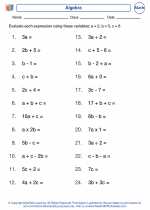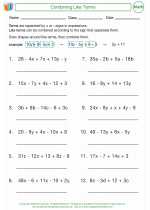Algebra -> higher-degree polynomials
Higher-Degree Polynomials Study Guide
What is a Polynomial?
A polynomial is an expression consisting of variables (or indeterminates) and coefficients, that involves only the operations of addition, subtraction, multiplication, and non-negative integer exponents of variables.
Degree of a Polynomial
The degree of a polynomial is the highest power of the variable in the polynomial. For example, in the polynomial 3x^2 + 2x - 5, the degree is 2.
Higher-Degree Polynomials
Higher-degree polynomials are polynomials with a degree greater than 2. These polynomials can have complex shapes and multiple turning points when graphed. They can also have multiple real or complex roots.
Key Concepts
- Leading Coefficient: The coefficient of the term with the highest power in a polynomial.
- Turning Points: Points on the graph of a polynomial where the direction of the curve changes.
- Real and Complex Roots: The values of the variable for which the polynomial equals zero.
How to Solve Higher-Degree Polynomials
To solve higher-degree polynomials, you can use methods such as factoring, the quadratic formula, synthetic division, or graphing techniques. Understanding the properties of the polynomial, such as the number of real and complex roots, can help in determining the approach to use for solving it.
Practice Problems
1. Find the degree of the polynomial: 4x^3 - 2x^2 + 7x - 1
2. Determine the leading coefficient of the polynomial: 2x^4 + 3x^2 - 5x + 1
3. Graph the polynomial y = x^3 - 2x^2 + x - 1
Answers
1. The degree of the polynomial 4x^3 - 2x^2 + 7x - 1 is 3.
2. The leading coefficient of the polynomial 2x^4 + 3x^2 - 5x + 1 is 2.
3. The graph of the polynomial y = x^3 - 2x^2 + x - 1 will have a shape with turning points and may intersect the x-axis at various points.
.◂Math Worksheets and Study Guides Fifth Grade. Algebra

 Activity Lesson
Activity Lesson
 Activity Lesson
Activity Lesson
 Activity Lesson
Activity Lesson
 Activity Lesson
Activity Lesson
 Worksheet/Answer key
Worksheet/Answer key
 Worksheet/Answer key
Worksheet/Answer key
 Worksheet/Answer key
Worksheet/Answer key
 Worksheet/Answer key
Worksheet/Answer key
 Worksheet/Answer key
Worksheet/Answer key
 Worksheet/Answer key
Worksheet/Answer key
 Worksheet/Answer key
Worksheet/Answer key
 Vocabulary/Answer key
Vocabulary/Answer key
